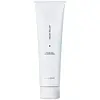What's inside
What's inside
 Key Ingredients
Key Ingredients

 Benefits
Benefits

 Concerns
Concerns

 Ingredients Side-by-side
Ingredients Side-by-side

Water
Skin ConditioningSodium Lauryl Sulfate
CleansingCocamidopropyl Betaine
CleansingAcrylates/Steareth-20 Methacrylate Copolymer
PEG/PPG-8/3 Diisostearate
EmulsifyingTriethanolamine
BufferingSalicylic Acid
MaskingOlive Oil PEG-7 Esters
EmollientSodium PEG-7 Olive Oil Carboxylate
EmulsifyingPEG-12 Dimethicone
Skin ConditioningGlycerin
HumectantDMDM Hydantoin
PreservativeParfum
MaskingMethylparaben
PreservativeGuar Hydroxypropyltrimonium Chloride
Skin ConditioningDisodium EDTA
Water, Sodium Lauryl Sulfate, Cocamidopropyl Betaine, Acrylates/Steareth-20 Methacrylate Copolymer, PEG/PPG-8/3 Diisostearate, Triethanolamine, Salicylic Acid, Olive Oil PEG-7 Esters, Sodium PEG-7 Olive Oil Carboxylate, PEG-12 Dimethicone, Glycerin, DMDM Hydantoin, Parfum, Methylparaben, Guar Hydroxypropyltrimonium Chloride, Disodium EDTA
Water
Skin ConditioningPropanediol
SolventGlycerin
HumectantDecyl Glucoside
CleansingSodium Cocoyl Glutamate
CleansingPentylene Glycol
Skin ConditioningNiacinamide
SmoothingAvena Sativa Kernel Oil
Skin ConditioningRubus Idaeus Seed Oil
EmollientAllantoin
Skin ConditioningCentella Asiatica Callus Conditioned Media
Skin ConditioningFructose
HumectantInulin
Skin ConditioningUrea
BufferingGlucose
HumectantYeast Extract
Skin ConditioningMaltose
MaskingSodium Lactate
BufferingSodium PCA
HumectantTrehalose
HumectantSodium Hyaluronate
HumectantCitric Acid
BufferingCellulose Gum
Emulsion StabilisingPropylene Glycol
HumectantXanthan Gum
EmulsifyingBenzyl Alcohol
PerfumingDehydroacetic Acid
PreservativeSodium Hydroxide
BufferingCellulose
AbsorbentSodium Chloride
Masking1,2-Hexanediol
Skin ConditioningCaprylyl Glycol
EmollientWater, Propanediol, Glycerin, Decyl Glucoside, Sodium Cocoyl Glutamate, Pentylene Glycol, Niacinamide, Avena Sativa Kernel Oil, Rubus Idaeus Seed Oil, Allantoin, Centella Asiatica Callus Conditioned Media, Fructose, Inulin, Urea, Glucose, Yeast Extract, Maltose, Sodium Lactate, Sodium PCA, Trehalose, Sodium Hyaluronate, Citric Acid, Cellulose Gum, Propylene Glycol, Xanthan Gum, Benzyl Alcohol, Dehydroacetic Acid, Sodium Hydroxide, Cellulose, Sodium Chloride, 1,2-Hexanediol, Caprylyl Glycol
Ingredients Explained
These ingredients are found in both products.
Ingredients higher up in an ingredient list are typically present in a larger amount.
Glycerin is already naturally found in your skin. It helps moisturize and protect your skin.
A study from 2016 found glycerin to be more effective as a humectant than AHAs and hyaluronic acid.
As a humectant, it helps the skin stay hydrated by pulling moisture to your skin. The low molecular weight of glycerin allows it to pull moisture into the deeper layers of your skin.
Hydrated skin improves your skin barrier; Your skin barrier helps protect against irritants and bacteria.
Glycerin has also been found to have antimicrobial and antiviral properties. Due to these properties, glycerin is often used in wound and burn treatments.
In cosmetics, glycerin is usually derived from plants such as soybean or palm. However, it can also be sourced from animals, such as tallow or animal fat.
This ingredient is organic, colorless, odorless, and non-toxic.
Glycerin is the name for this ingredient in American English. British English uses Glycerol/Glycerine.
Learn more about GlycerinWater. It's the most common cosmetic ingredient of all. You'll usually see it at the top of ingredient lists, meaning that it makes up the largest part of the product.
So why is it so popular? Water most often acts as a solvent - this means that it helps dissolve other ingredients into the formulation.
You'll also recognize water as that liquid we all need to stay alive. If you see this, drink a glass of water. Stay hydrated!
Learn more about Water